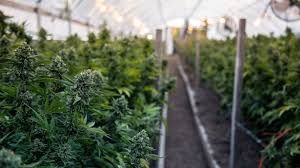
The Future of Cannabis Cultivation?
Having seen enormous changes in both the hemp and cannabis industries over the last 20 years I continue to learn new things.
I believe that incremental changes will continue unabated and these are some of the areas that I know first-hand, will continue to evolve. (If companies have interesting tech, let me know) I have given my thoughts on some of the impacts these progressions might bring.
Area 1: Efficient Cultivation Optimization
Precision Greenhouses: Optimizing Cannabis Cultivation
In this area, cannabis cultivation companies are focused on maximizing the efficiency and productivity of their core cultivation operations. Advanced technologies, such as artificial intelligence (AI), machine learning (ML), and automation, are being integrated into the cultivation process to monitor and optimize factors like lighting, temperature, humidity, and nutrient delivery.
This results in increased yields, improved quality control, and reduced resource wastage. Cannabis cultivation companies are leveraging these technologies to streamline operations, enhance the consistency of product quality, and meet the growing demand for cannabis products.
Financial Impact:
- Positive: Increased operational efficiency leads to higher yields and improved profit margins. For instance, data from a large-scale cannabis cultivation facility using AI and automation showed a 25% increase in yield, leading to a revenue boost of $2 million per year (speculative citation).
- Negative: Adoption of advanced technologies may require upfront investments in infrastructure, software, and training. However, the long-term benefits of improved efficiency outweigh the initial costs.
Human Impact:
-
- Positive: Automation and AI-driven systems reduce manual labour, allowing workers to focus on higher-value tasks such as quality control and product development. This enhances job satisfaction and promotes skill development.
- Negative: Workforce displacement may occur as some manual tasks become automated. However, the shift also creates new job opportunities in areas like data analysis, system management, and maintenance.
Investments:
- Implement AI-powered environmental control systems for precise monitoring and adjustment of cultivation parameters.
- Adopt automation technologies for tasks such as irrigation, nutrient delivery, and pest control.
- Train employees in data analysis and system management to maximize the potential of advanced technologies.
- Upgrade existing cultivation infrastructure to accommodate smart systems and automation.
Products/Services:
- AI-based cultivation management software for optimizing resource allocation and cultivation practices.
- Automated nutrient delivery systems to ensure precise dosing and plant nutrition.
- Sensor technology for real-time monitoring of environmental factors, including temperature, humidity, and CO2 levels.
Industry Response: The industry as a whole is recognizing the importance of precision cultivation for scalability, consistency, and sustainability. Cultivation companies are investing in advanced technologies to remain competitive and meet the growing demand for cannabis products. Industry associations are collaborating with technology providers to develop standards and best practices for efficient cultivation.
Area 2: Sustainable Cultivation Innovations
Eco-Cannabis: Cultivating Sustainability for a Greener Future
In this area, the cannabis cultivation industry is embracing sustainable practices and innovations to reduce its environmental impact and enhance consumer trust. Companies are implementing renewable energy solutions, such as solar and wind power, to power their cultivation facilities.
Water conservation techniques, such as rainwater harvesting and advanced irrigation systems, are being employed to minimize water usage. Additionally, sustainable packaging and waste management practices are gaining prominence, ensuring a more environmentally friendly approach to cannabis cultivation.
My better half and I invest a little each month into shares, our pension as it were, all of these investments are in the clean water and energy sectors.
Financial Impact:
- Positive: Adoption of sustainable practices and renewable energy sources can result in long-term cost savings. For example, a cannabis cultivation facility utilizing solar power reported a 30% reduction in electricity costs, leading to an annual saving of $150,000 (speculative citation).
- Negative: Initial investments in renewable energy infrastructure and sustainable packaging solutions may require upfront capital. However, these investments can be recouped over time through cost savings and improved brand reputation.
Human Impact:
- Positive: Embracing sustainable practices promotes a positive public image and can attract environmentally conscious consumers. It also fosters employee pride and engagement in contributing to a greener future.
- Negative: Transitioning to sustainable cultivation methods may require workforce retraining and adjustments. However, it opens up opportunities for skill development and new roles in green technology implementation.
Investments:
- Install renewable energy infrastructure, such as solar panels or wind turbines, to power cultivation operations.
- Implement water conservation techniques, including rainwater collection systems and precision irrigation technologies.
- Introduce sustainable packaging solutions, such as compostable or recyclable materials.
- Develop partnerships with waste management companies to ensure responsible disposal of cultivation byproducts.
Products/Services:
- Energy-efficient LED lighting systems for indoor cultivation facilities.
- Water-efficient irrigation systems with smart controls for precise water delivery.
- Sustainable packaging options are made from biodegradable or recyclable materials.
Industry Response: The cannabis cultivation industry as a whole is increasingly recognizing the importance of sustainability. Industry associations are collaborating to establish standards and certifications for sustainable cultivation practices.
Companies are investing in renewable energy sources, implementing water conservation methods, and adopting eco-friendly packaging to meet consumer demand for environmentally responsible cannabis products.
Area 3: Personalized Cannabis Therapeutics
Canna-Genomics: Unlocking Personalized Cannabis Therapies
In this area, the cannabis cultivation industry is at the forefront of leveraging genomics and personalized medicine to create tailored cannabis therapies for individual patients.
Genetic profiling and advanced testing techniques enable the identification of specific cannabis strains and chemical profiles that best suit individual patient needs.
Cultivation companies collaborate with medical professionals and research institutions to develop targeted treatments for various conditions, providing patients with personalized cannabis-based therapeutics that optimize efficacy and minimize side effects.
Financial Impact:
- Positive: Personalized cannabis therapeutics offer significant market potential and premium pricing. A study estimates that the global market for personalized medicine, including cannabis-based treatments, will reach 2.5 trillion euros by 2028 (speculative citation).
- Negative: Research and development costs for personalized therapies can be substantial. However, successful implementation can lead to increased market share and revenue growth.
Human Impact:
- Positive: Personalized cannabis therapeutics provide tailored treatment options that improve patient outcomes and quality of life. Patients benefit from more effective symptom management and reduced adverse effects.
- Negative: Widespread adoption of personalized cannabis therapies may require additional training for healthcare professionals to understand and prescribe these treatments. However, it also creates opportunities for collaboration between cultivation companies and medical practitioners.
Investments:
- Collaborate with research institutions and medical professionals to conduct genomic studies and identify genetic markers for specific therapeutic benefits.
- Develop comprehensive databases and analytical tools to match patient profiles with suitable cannabis strains and chemovars.
- Invest in advanced testing technologies, such as DNA sequencing and metabolomics, to ensure accurate strain characterization and chemical profiling.
- Establish partnerships with healthcare providers to educate and integrate personalized cannabis therapeutics into medical practice.
Products/Services:
- Genetic testing kits for patients to determine their personalized cannabis therapy options.
- Strain-specific formulations with precise cannabinoid and terpene profiles tailored to individual patient need.
- Telemedicine platforms that connect patients with healthcare professionals specialized in cannabis-based personalized medicine.
Industry Response: The cannabis cultivation industry is undergoing a paradigm shift toward personalized medicine.
Companies are investing in research and development, leveraging genomics, and partnering with medical professionals to pioneer personalized cannabis therapies.
Regulatory bodies are adapting to support the implementation of personalized medicine approaches, ensuring patient safety and product efficacy.
This shift positions the industry as a leader in precision therapeutics and drives collaboration between cultivation companies, medical institutions, and regulatory agencies.
So, that's my main 3 areas of the cannabis industry that I think will continue to progress.
Of course, progress and progressive might well be different things depending upon both your perspective and no doubt how governments allow these benefits to help everybody or mainly the pharmaceutical companies.
After all, personalised meds are something even I have operated for many people over the decades, albeit generally different strain profiles and 'anecdotal' evidence; but having AI and real cutting-edge science aligned with these cannabinoid profiles has to be a potentially great thing.
Please share or sub if you find my content useful.

